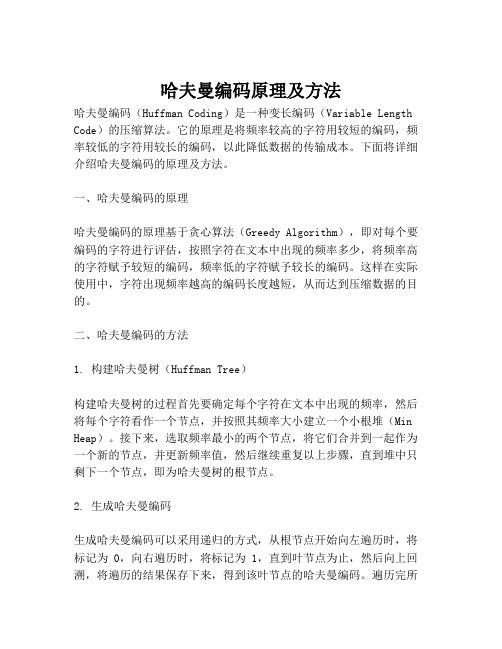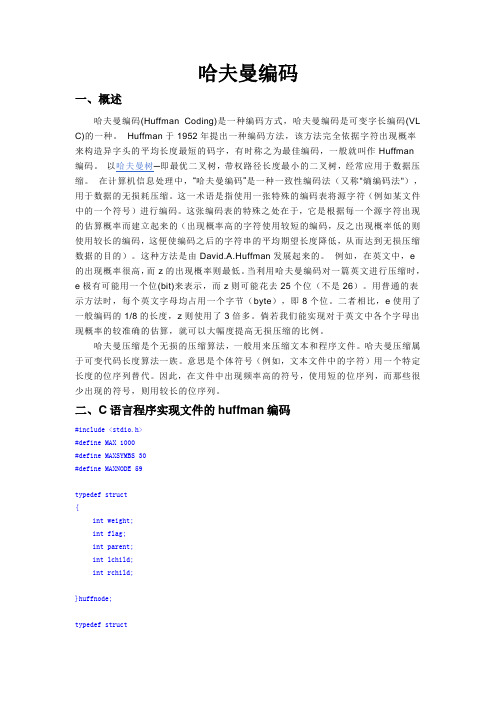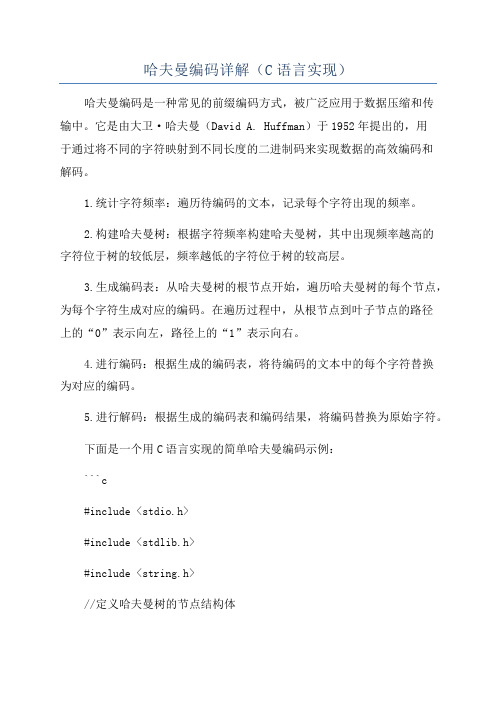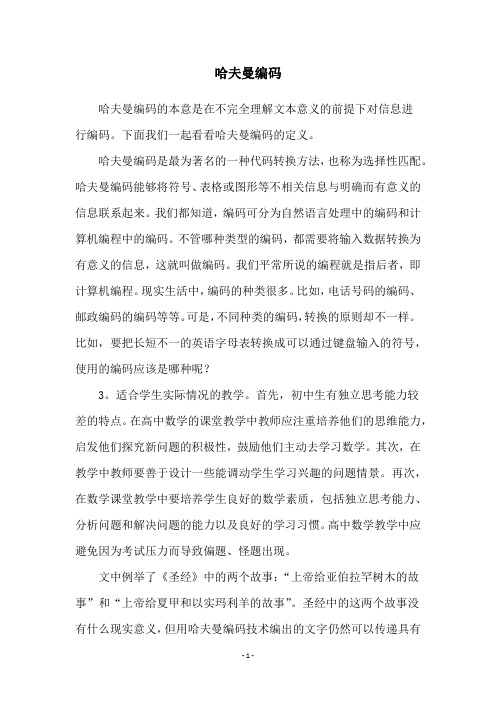哈夫曼编码
哈夫曼编码的实现及应用

哈夫曼编码的实现及应用哈夫曼编码(Huffman Coding)是一种用于数据压缩的编码技术,它可以将数据中频繁出现的字符或符号用较短的编码表示,从而减小数据的存储或传输开销。
以下是哈夫曼编码的实现和应用:实现哈夫曼编码:1. 构建哈夫曼树:首先,需要收集数据中不同字符或符号的频率信息,然后根据这些频率构建哈夫曼树。
在哈夫曼树中,频率较高的字符位于树的较低部分,频率较低的字符位于树的较高部分。
2. 分配编码:从根节点开始,沿着哈夫曼树的路径向下,为每个字符分配唯一的编码。
左子树通常表示0,右子树表示1。
这确保了编码是前缀编码,即没有一个编码是另一个编码的前缀。
3. 编码数据:使用分配的编码,将原始数据中的字符替换为相应的编码,从而生成压缩的数据。
哈夫曼编码的应用:1. 数据压缩:哈夫曼编码广泛用于数据压缩领域,包括压缩文件、图像、音频和视频数据。
由于频率较高的字符使用较短的编码,哈夫曼编码可以显著减小文件大小。
2. 通信系统:在通信系统中,数据通常需要在网络上传输。
使用哈夫曼编码可以减小数据传输的带宽要求,提高通信效率。
3. 文本编辑器:哈夫曼编码可用于实现字典压缩,减小文本文件的大小,使其更容易存储和传输。
4. 图像压缩:JPEG图片格式使用了哈夫曼编码来压缩图像数据,减小图像文件的大小。
5. 音频压缩:MP3音频格式中的音频数据也使用了哈夫曼编码,以减小音频文件的大小。
6. 存储设备:存储设备,如硬盘和闪存驱动器,通常使用哈夫曼编码来提高存储效率,减小数据的物理存储需求。
哈夫曼编码是一种有效的数据压缩方法,可以在多个领域中应用,以减小数据的大小并提高数据传输和存储的效率。
不同应用领域可能会采用不同的编码方式,但核心原理是一致的。
哈夫曼编码python

哈夫曼编码python一、什么是哈夫曼编码?哈夫曼编码(Huffman Coding)是一种可变长度编码(Variable Length Code),它可以将不同长度的字符编码成等长的二进制串,从而实现数据压缩的目的。
哈夫曼编码是由David A. Huffman在1952年发明的,它是一种贪心算法,可以得到最优解。
二、哈夫曼编码原理1.字符频率统计在进行哈夫曼编码之前,需要先统计每个字符出现的频率。
通常使用一个字典来存储每个字符和其出现的次数。
2.构建哈夫曼树根据字符出现频率构建一个二叉树,其中频率越高的字符离根节点越近。
构建过程中需要用到一个优先队列(Priority Queue),将每个节点按照频率大小加入队列中,并将队列中前两个节点合并为一个新节点,并重新加入队列中。
重复这个过程直到只剩下一个节点,即根节点。
3.生成哈夫曼编码从根节点开始遍历哈夫曼树,在遍历过程中,左子树走0,右子树走1,直到叶子节点。
将路径上经过的0和1分别表示为0和1位二进制数,并把这些二进制数拼接起来,就得到了该字符的哈夫曼编码。
三、哈夫曼编码Python实现下面是一个简单的Python实现:1.字符频率统计```pythonfrom collections import Counterdef get_char_frequency(text):"""统计每个字符出现的频率"""return Counter(text)```2.构建哈夫曼树```pythonimport heapqclass HuffmanNode:def __init__(self, char=None, freq=0, left=None, right=None): self.char = charself.freq = freqself.left = leftself.right = rightdef __lt__(self, other):return self.freq < other.freqdef build_huffman_tree(char_freq):"""根据字符频率构建哈夫曼树"""nodes = [HuffmanNode(char=c, freq=f) for c, f inchar_freq.items()]heapq.heapify(nodes)while len(nodes) > 1:node1 = heapq.heappop(nodes)node2 = heapq.heappop(nodes)new_node = HuffmanNode(freq=node1.freq+node2.freq, left=node1, right=node2)heapq.heappush(nodes, new_node)return nodes[0]```3.生成哈夫曼编码```pythondef generate_huffman_codes(node, code="", codes={}): """生成哈夫曼编码"""if node is None:returnif node.char is not None:codes[node.char] = codegenerate_huffman_codes(node.left, code+"0", codes) generate_huffman_codes(node.right, code+"1", codes)return codes```四、使用哈夫曼编码进行压缩使用哈夫曼编码进行压缩的方法很简单,只需要将原始数据中的每个字符用对应的哈夫曼编码替换即可。
哈夫曼编码代码

哈夫曼编码代码哈夫曼编码代码 1因为哈夫曼树的特点是:叶子结点权值越大的,离根越近。
又因为构造不等长编码的原则是:字符使用频率越高,编码越短,故采用哈夫曼树进行编码可以得到最优前缀编码。
约定左分支标记为0, 右分支标记为 1哈夫曼编码代码 2为不浪费存储空间,动态分配一个长度为n(字符编码长度一定小于n) 的一维数组cd, 用来临时存放当前正在求解的第i 个字符的编码,当第i个字符的编码求解完毕后,根据数组cd的字符串长度分配HC[i]的空间,然后将数组cd中的编码复制到HC[i]中。
依照上一篇文章的哈夫曼树:哈夫曼编码表HC:注意:由于哈夫曼树不唯一,故哈夫曼编码也不唯一。
代码如下:#include<stdio.h>#include<iostream>typedefstruct{int weight;int parent, lchild,rchild;}HTNode,*HuffmanTree;voidSelect(HuffmanTree&HT,int n,int&s1,int&s2){int min;for(int i =1; i <= n; i++){if(HT[i].parent ==0){min = i;break;}}for(int i =1; i <= n;i++){if(HT[i].parent ==0){if(HT[i].weight <HT[min].weight){min = i;}}}s1 = min;for(int i =1; i <= n;i++){if(HT[i].parent ==0&& i != s1){min = i;break;}}for(int i =1; i <= n;i++){if(HT[i].parent ==0&& i != s1){if(HT[i].weight < HT[min].weight){min = i;}}}s2 = min;}voidprintln(HuffmanTree &HT,intm){printf("==============================\n");for(inti =1; i <= m; i++){printf("%d, ", i);printf("%d ", HT[i].weight);printf("%d ", HT[i].parent);printf("%d ", HT[i].lchild);printf("%d \n",HT[i].rchild);printf("---------------------------\n");}}voidCreateHuffmanTree(HuffmanTree &HT,intn,int*ht){int i, m =2* n -1, s1, s2;if(n <=1)return;HT =new HTNode[m +1];for(i =1; i <= m;++i){HT[i].parent =0;HT[i].lchild =0;HT[i].rchild =0;}for(i =1; i <= n;++i){HT[i].weight = ht[i -1];}printf("\nHT的初态\n");println(HT, m);for(int i = n +1; i <=m;++i){Select(HT, i -1, s1, s2);HT[s1].parent = i;HT[s2].parent = i;HT[i].lchild = s1;HT[i].rchild = s2;HT[i].weight = HT[s1].weight +HT[s2].weight;}printf("\nHT的终态\n");println(HT, m);}typedefchar**HuffmanCode;char*cd;intstart;voidCreatHuffmanCode(HuffmanTree HT, HuffmanCode &HC,int n){int i, c, f;HC =newchar*[n +1];cd =newchar[n];cd[n -1]='\0';for(i =1; i <= n;++i){start = n -1;c = i;f = HT[i].parent;while(f !=0){if(HT[f].lchild == c) cd[--start]='0';else cd[--start]='1';c = f;f = HT[f].parent;}HC[i]=newchar[n -start];strcpy(HC[i],&cd[start]);printf("第%d组--->", i);for(int j = start; j <= n -1;++j){printf("%c ",cd[j]);}printf("\n");}delete cd;}intmain(){HuffmanTree HT;HuffmanCode HC;int n =8;intht[8]={5,29,7,8,14,23,3,11};CreateHuffmanTree(HT, n, ht);CreatHuffmanCode(HT, HC, n);}运行结果:。
哈夫曼编码名词解释

哈夫曼编码名词解释哈夫曼编码是一种用于数据压缩的编码方式。
由于它可以减小文件的体积,并且在传输文件时速度更快,因此在实际应用中非常重要。
哈夫曼编码一些重要的名词解释如下:一、频率频率是指特定字符在文本中出现的次数。
在哈夫曼编码中,频率用于计算每个字符的权重,权重越高的字符,使用的编码位数越少。
二、前缀码前缀码是指没有任何码字是其它码字的前缀的编码方式。
哈夫曼编码就是一种前缀码,没有任何哈夫曼编码的码字是其它码字的前缀,这是保证哈夫曼编码解码准确性的关键所在。
三、码树码树是一种包含权重、编码、二进制位数的树形数据结构。
在哈夫曼编码中,码树由文本中出现的字符的频率构成,每个字符用一个叶节点代表,叶节点和中间节点通过一个编码连接起来。
四、权重权重是指字符在文本中出现的频率,在哈夫曼编码中,它用于计算每个字符在编码中的位数,权重越高的字符使用的编码位数越少。
五、码字码字是指表示一个字符的二进制编码,长度不同的码字代表着不同权重的字符。
六、编码编码是将字符或数据转化为码字的过程,在哈夫曼编码中,通过经过计算得出的权重来生成码字。
七、解码解码是将码字转化为字符或数据的过程,在哈夫曼编码中,根据每个字符的码字和频率生成码树,在树中查找出对应的字符,从而将码字还原为原始的字符。
八、二进制二进制是计算机中表示数字的一种方式,它只包含0和1两种数值,在哈夫曼编码中,使用二进制来表示每个字符的码字。
总之,哈夫曼编码在很多领域都有着重要的应用,了解这些关键名词的含义将更好的理解和掌握它的原理,也会帮助你更好的使用它。
哈夫曼编码计算

哈夫曼编码是一种根据字符出现频率创建的编码方式,其中频率高的字符使用较短的编码,频率低的字符使用较长的编码。
以下是计算哈夫曼编码的步骤:
1. 创建一个森林,每个字符出现频率作为一棵树的权值,每个树只有一个节点。
2. 从森林中取出两棵权值最小的树,合并它们,生成一棵新的树。
新树的权值是这两棵树的权值之和,左子树是原来的左树,右子树是原来的右树。
3. 将新生成的树放回森林中。
4. 重复步骤2和3,直到森林中只剩下一棵树为止,这棵树就是哈夫曼树。
5. 哈夫曼编码是从哈夫曼树的根节点到叶节点的路径,按照从左到右的顺序,用0和1表示路径的方向。
举个例子,假设我们有4个字符(a、b、c、d),它们的出现频率分别为1、2、3、4。
根据这些频率,我们可以建立以下森林:
1. a -> 1
2. b -> 2
3. c -> 3
4. d -> 4
然后,我们按照上述步骤合并权值最小的两个节点,生成新的节点,并反复进行这个过程,直到得到一棵只有根节点的树。
最后,从根节点到每个叶节点的路径就是每个字符的哈夫曼编码。
需要注意的是,哈夫曼编码是一种无损压缩算法,它不会丢失原始数据的信息。
但是,它并不适用于所有情况,特别是当字符出现频率相差很大时,哈夫曼编码的效果可能会受到影响。
哈夫曼编码原理及方法

哈夫曼编码原理及方法哈夫曼编码(Huffman Coding)是一种变长编码(Variable Length Code)的压缩算法。
它的原理是将频率较高的字符用较短的编码,频率较低的字符用较长的编码,以此降低数据的传输成本。
下面将详细介绍哈夫曼编码的原理及方法。
一、哈夫曼编码的原理哈夫曼编码的原理基于贪心算法(Greedy Algorithm),即对每个要编码的字符进行评估,按照字符在文本中出现的频率多少,将频率高的字符赋予较短的编码,频率低的字符赋予较长的编码。
这样在实际使用中,字符出现频率越高的编码长度越短,从而达到压缩数据的目的。
二、哈夫曼编码的方法1. 构建哈夫曼树(Huffman Tree)构建哈夫曼树的过程首先要确定每个字符在文本中出现的频率,然后将每个字符看作一个节点,并按照其频率大小建立一个小根堆(Min Heap)。
接下来,选取频率最小的两个节点,将它们合并到一起作为一个新的节点,并更新频率值,然后继续重复以上步骤,直到堆中只剩下一个节点,即为哈夫曼树的根节点。
2. 生成哈夫曼编码生成哈夫曼编码可以采用递归的方式,从根节点开始向左遍历时,将标记为 0,向右遍历时,将标记为 1,直到叶节点为止,然后向上回溯,将遍历的结果保存下来,得到该叶节点的哈夫曼编码。
遍历完所有的叶子节点后,即可得到所有字符的哈夫曼编码。
3. 压缩数据在使用哈夫曼编码进行数据压缩时,将字符替换为其对应的哈夫曼编码,这样可以将原始数据压缩为更小的数据量,达到压缩数据的目的。
在解压数据时,需要根据已生成的哈夫曼树,将压缩后的数据转换为原始数据,即将哈夫曼编码转换为对应的字符。
三、哈夫曼编码的优缺点哈夫曼编码的优点是具有压缩比高、压缩速度快、压缩后的数据无损还原等特点,可以广泛用于图像、音频、视频等多种数据类型的压缩。
同时,由于哈夫曼编码采用变长编码方式,所以可以使用相对较短的编码表示经常出现的字符,从而达到更好的压缩效果。
哈夫曼编码

哈夫曼编码一、概述哈夫曼编码(Huffman Coding)是一种编码方式,哈夫曼编码是可变字长编码(VL C)的一种。
Huffman于1952年提出一种编码方法,该方法完全依据字符出现概率来构造异字头的平均长度最短的码字,有时称之为最佳编码,一般就叫作Huffman编码。
以哈夫曼树─即最优二叉树,带权路径长度最小的二叉树,经常应用于数据压缩。
在计算机信息处理中,“哈夫曼编码”是一种一致性编码法(又称"熵编码法"),用于数据的无损耗压缩。
这一术语是指使用一张特殊的编码表将源字符(例如某文件中的一个符号)进行编码。
这张编码表的特殊之处在于,它是根据每一个源字符出现的估算概率而建立起来的(出现概率高的字符使用较短的编码,反之出现概率低的则使用较长的编码,这便使编码之后的字符串的平均期望长度降低,从而达到无损压缩数据的目的)。
这种方法是由David.A.Huffman发展起来的。
例如,在英文中,e的出现概率很高,而z的出现概率则最低。
当利用哈夫曼编码对一篇英文进行压缩时,e极有可能用一个位(bit)来表示,而z则可能花去25个位(不是26)。
用普通的表示方法时,每个英文字母均占用一个字节(byte),即8个位。
二者相比,e使用了一般编码的1/8的长度,z则使用了3倍多。
倘若我们能实现对于英文中各个字母出现概率的较准确的估算,就可以大幅度提高无损压缩的比例。
哈夫曼压缩是个无损的压缩算法,一般用来压缩文本和程序文件。
哈夫曼压缩属于可变代码长度算法一族。
意思是个体符号(例如,文本文件中的字符)用一个特定长度的位序列替代。
因此,在文件中出现频率高的符号,使用短的位序列,而那些很少出现的符号,则用较长的位序列。
二、C语言程序实现文件的huffman编码#include <stdio.h>#define MAX 1000#define MAXSYMBS 30#define MAXNODE 59typedef struct{int weight;int flag;int parent;int lchild;int rchild;}huffnode;typedef struct{int bits[MAXSYMBS];int start;}huffcode;void main(){huffnode huff_node[MAXNODE];huffcode huff_code[MAXSYMBS],cd;int i,j,m1,m2,x1,x2,n,c,p; /*char symbs[MAXSYMBS],symb;*//*数组buff_node初始化*/printf("please input the leaf num of tree:\n");scanf("%d",&n);for(i=0;i<2*n-1;i++){huff_node[i].weight=0;huff_node[i].parent=0;huff_node[i].flag=0;huff_node[i].lchild=-1;huff_node[i].rchild=-1;}printf("please input the weight of every leaf\n");for(i=0;i<n-1;i++)scanf("%d",&huff_node[i].weight);/*构造哈弗曼树*/for(i=0;i<n-1;i++){m1=m2=MAX;x1=x2=0;for(j=0;j<n+i;j++){if(huff_node[j].weight <m1&&huff_node[j].flag ==0){m2=m1;x2=x1;m1=huff_node[j].weight ;x1=j;}else if (huff_node[j].weight <m2&&huff_node[j].flag ==0) {m2=huff_node[j].weight;x2=j;}}huff_node[x1].parent=n+i;huff_node[x2].parent=n+i;huff_node[x1].flag =1;huff_node[x2].flag =1;huff_node[n+i].weight =huff_node[x1].weight +huff_node[x2].weight ; huff_node[n+i].lchild =x1;huff_node[n+i].rchild =x2;}/*求字符的哈弗曼编码*/for(i=0;i<n;i++){cd.start =n;c=i;p=huff_node[c].parent ;while(p!=0){if(huff_node[p].lchild ==c)cd.bits [cd.start ]=0;elsecd.bits [cd.start ]=1;cd.start=cd.start -1;c=p;p=huff_node[p].parent ;}cd.start ++;for(j=cd.start ;j<=n;j++)huff_code[i].bits[j]=cd.bits [j];huff_code[i].start =cd.start ;}/*输出字符的哈弗曼编码*/puts("the hafman code are:");for(i=0;i<n;i++){for(j=huff_code[i].start;j<=n;j++)printf("%10d",huff_code[i].bits [j]);printf("/n");}puts("press any key to quit...");}三、运行界面please input the leaf num of tree:8please input the weight of every leaf 1 2 3 4 5 6 7 1输出:11010 1100 100 101 1110001 11011。
哈夫曼编码算法详解

哈夫曼编码算法详解在计算机科学中,哈夫曼编码是一种压缩算法,也叫做霍夫曼编码,是由霍夫曼(Huffman)在1952年首创的。
霍夫曼编码是一种无损压缩算法,可以对文本文件、音频文件、图像文件等各种类型的文件进行压缩。
1. 哈夫曼编码的原理哈夫曼编码是基于频率统计的思想,通过统计每个字符在文件中出现的频率,选择出现频率最高的字符,将其映射为一组比特位,出现频率较低的字符则映射为比高的比特位,从而实现对文件的压缩。
通过哈夫曼编码,可以将文件压缩到原始大小的一半甚至更小。
2. 哈夫曼编码的实现哈夫曼编码的实现需要进行几个步骤:2.1 统计字符的出现频率从文件中读取字符,统计每个字符在文件中出现的次数,可以使用一个数组或字典来保存每个字符的出现次数。
对于英文文本来说,出现频率最高的字符是空格,其次是字母“e”。
2.2 构建哈夫曼树将所有的字符按照出现频率从小到大排序,选出出现频率最小的两个字符作为左右子节点,其父节点的出现频率为左右子节点出现频率之和。
重复这个过程,直到节点数为1,这样就得到了一棵哈夫曼树。
2.3 生成哈夫曼编码从哈夫曼树的根节点开始,遍历所有的节点,将左子节点标记为0,将右子节点标记为1,将所有的叶子节点的字符和对应的哈夫曼编码保存到一个字典中。
最终得到了每个字符对应的哈夫曼编码。
2.4 进行压缩将文件中每个字符替换为对应的哈夫曼编码,然后将所有的哈夫曼编码拼接成一个二进制数,在最后不足8位的位置补零,将其存储到文件中。
这样就完成了文件的压缩。
3. 哈夫曼编码的优点哈夫曼编码具有以下优点:3.1 压缩率高由于哈夫曼编码是根据不同字符的出现频率来进行编码的,出现频率高的字符用较短的编码表示,出现频率低的字符用较长的编码表示,能够最大限度地减少文件的大小,从而达到高的压缩率。
3.2 唯一解哈夫曼编码是通过构建哈夫曼树来得到每个字符对应的编码,哈夫曼树的构建是唯一的,因此哈夫曼编码也是唯一的。
《信息论与编码》第5章哈夫曼编码

什么是哈夫曼编码方法
1952年由美国计算机科学家戴维· 哈夫曼先生提出 是一种数据压缩技术 该方法依据字符出现的概率进行编码 ,其基本思想为: 出现概率高的字符使用较短的编码 出现概率低的则使用较长的编码 使编码之后的码字的平均长度最短
哈夫曼编码方法
哈夫曼编码方法包含两个过程
哈夫曼编码方法包含两个过程
编码过程和译码过程
编码过程 译码过程
构建哈夫曼树 CreatHT(W,&HT)
输入是字符频度表W
表中记录的是原码报文中出现的不同符号个数和频率
输出是哈夫曼树HT
进行哈夫曼译码 HuffmanDecod(HT,CC,W,&OC)
输入的是哈夫曼树HT、代码报文CC和字符频度表W 输出的是原码报文OC
OC
输出OC 到哈夫曼译码系统之外 返回开头
字母a的编码为110 字母n的编码为111
1
4 n
因此,在电文中出现频率 高的字母的编码相对短, 而出现频率低的字母的编 码相对长
111 字符编码表HC=((d,0),(i,10),(a,110),(n,111))
哈夫曼编码过程演示
编码 A1 A2 A3 0.23 0.21 0.18
1
0 1 0 1 0.10 0
编码过程和译码过程
编码过程
构建哈夫曼树 CreatHT(W,&HT)
输入是字符频度表W
表中记录的是原码报文中出现的不同符号个数和频率
输出是哈夫曼树HT
进行哈夫曼编码 HuffmanCoding(HT,&HC)
输入是哈夫曼树HT 输出是字符编码表HC
哈夫曼编码资料讲解

P
0.22 0.20 0.18 0.15 0.10 0.08 0.05 0.02
码字 1 2 3 00 01 02 030 031
例•5-信9 源输出2个符号,概率分布为P=(0.9,0.1),信 源熵H(X)=H(0.9)=0.469。采用二进制哈夫曼编 码。 L=1, 1=1bit/符号; L=2,P’=(0.81,0.09,0.09,0.01), 2=0.645bit/符号; L=3, K 3=0.533bit/符号; L=4, 4=0.493bit/符号。 随着序K列长度L的增加,平均码长迅速降低,接近 信息源熵值,K 编码效率接近于1.
K
一般情况下,信源符号以恒速输出,信道也是恒速传 输的。通过编码后,会造成编码输出每秒的比特数 不是常量,因而不能直接由信道来传送。为了适应 信道,必须增加缓冲寄存器。将编码输出暂存在缓 冲器中,然后再由信道传输,使输入和输出的速率 保持平衡。
溢出:当信源连续输出低概率符号时,因为码长较长, 有可能使缓冲器存不下而溢出。
0110 4
0111 4
该哈夫曼编码的平均码长
7
K p(ai)Ki 2.72码元/符号 i1
信息传输速率
RH(X)2.610.96Bit/码元 K 2.72
哈夫曼编码方法得到的码并非唯一的
1 每次对信源缩减时,赋予信源最后两个概率最小的符号, 用0和1是可以任意的,所以可以得到不同的哈夫曼码,但 不会影响码字的长度。
编码过程
0.4
0.4
0.6 0 1.0
0.2
0.4 0 0.4 1
0.2 0
0.2 1
0.2 1
码字 码长
1
1
01 2
000 3
哈夫曼编码

哈夫曼编码
1952年哈夫曼提出了一种构造最佳码的方法 称之为哈夫曼编码。 哈夫曼编码适用于多元独立信源
对于独立信源来说,哈夫曼编码是最佳码 他充分的利用了信源的概率特性进行编码,
编码方法
(1)将信源消息符号按其出现的概率大小依次 排列 (2)取两个概率最小的字母分别配以0和1两个 码元,并将这两个概率相加作为一个新字 母的概率,与未分配的二进符号的字母重 新排队
1 哈夫曼码的编码方法保证了概率大的符号对应于 短码,概率小的符号对应于长码,充分利用了短 码。 2 缩减信源的最后二个码字总是最后一位不同,从 而保证了哈夫曼码是即时码。 3 每次缩减信源的最长两个码字有相同的码长。 三个特点保证了哈夫曼码是最佳码
多进制哈夫曼编码
对于多进制哈夫曼码,为了提高编码效率, 就要使长码的符号数量尽量少、概率尽量 小,所以信源符号数量尽量满足
编码方法
(3)对重排后的两个概率最小符号重复步骤(2) 的过程。
(4)不断继续上述过程,直到最后两个符号配 以0和1为止。 (5)从最后一级开始,向前返回得到各个信源 符号所对应的码元序列,即相应的码字。
例5-7
信源 符号 概率 0.20 编码过程 码字 码 长 0.39 0.35 0 0.26 1 10 0.61 0 1.0 11 0.39 1 000 001 2
编码效率也相等
H(X ) 0.965 K
码方差 码字长度偏离平均长度的程度
l2 E k i K
p(a )(k
2 q i 1 i
i
K )2
第一种哈夫曼码的码方差
1.36
2 l1
第二种哈夫曼码的码方差
0.16
哈夫曼编码

• 哈夫曼(Huffman)编码是一种常用的压缩编码方法, 是Huffman于1952年为压缩文本文件建立的。
• 基本思想 – 通过减少编码冗余来达到压缩的目的。 – 统计符号的出现概率,建立一个概率统计表 • 将最常出现(概率大的)的符号用最短的编码, • 最少出现的符号用最长的编码。
01 20 0 1
40 0 1 0 1 30
0
10
(7)分配码字。将形成的二叉树的左节点标0,右节点 标1。把从最上面的根节点到最下面的叶子节点途中遇到的 0,1序列串起来,就得到了各级灰度的编码.
30 10 20 40 20 40 0 20 20 20 30 30 20 40 40 20
01 20 0 1
霍夫曼编码举例
30 10 20 40 20 40 0 20 20 20 30 30 20 40 40 20
(1) 统计出每级灰度出现的频率: 灰度值: 0 10 20 30 40 出现频率: 1/16 1/16 7/16 3/16 4/16
30 10 20 40 20 40 0 20 20 20 30 30 20 40 40 20
2/16 3/16 5/16 7/16
5/16 30 10 20 40
20 40 0 20
2/16
20 20 30 30
3/16
20 40 40 20
1/16
1/16
(4) 选出频率最小的两个值(2/16,3/16)作为二叉 树的两个叶子节点,将频率和5/16作为它们的根节点,新的 根节点再参与其它频率排序:
(2)从左到右把上述频率按从小到大的顺序排列。 灰度值: 0 10 30 40 20 出现频率: 1/16 1/16 3/16 4/16 7/16
哈夫曼编码详解(C语言实现)

哈夫曼编码详解(C语言实现)哈夫曼编码是一种常见的前缀编码方式,被广泛应用于数据压缩和传输中。
它是由大卫·哈夫曼(David A. Huffman)于1952年提出的,用于通过将不同的字符映射到不同长度的二进制码来实现数据的高效编码和解码。
1.统计字符频率:遍历待编码的文本,记录每个字符出现的频率。
2.构建哈夫曼树:根据字符频率构建哈夫曼树,其中出现频率越高的字符位于树的较低层,频率越低的字符位于树的较高层。
3.生成编码表:从哈夫曼树的根节点开始,遍历哈夫曼树的每个节点,为每个字符生成对应的编码。
在遍历过程中,从根节点到叶子节点的路径上的“0”表示向左,路径上的“1”表示向右。
4.进行编码:根据生成的编码表,将待编码的文本中的每个字符替换为对应的编码。
5.进行解码:根据生成的编码表和编码结果,将编码替换为原始字符。
下面是一个用C语言实现的简单哈夫曼编码示例:```c#include <stdio.h>#include <stdlib.h>#include <string.h>//定义哈夫曼树的节点结构体typedef struct HuffmanNodechar data; // 字符数据int freq; // 字符出现的频率struct HuffmanNode *left; // 左子节点struct HuffmanNode *right; // 右子节点} HuffmanNode;//定义编码表typedef structchar data; // 字符数据char *code; // 字符对应的编码} HuffmanCode;//统计字符频率int *countFrequency(char *text)int *frequency = (int *)calloc(256, sizeof(int)); int len = strlen(text);for (int i = 0; i < len; i++)frequency[(int)text[i]]++;}return frequency;//创建哈夫曼树HuffmanNode *createHuffmanTree(int *frequency)//初始化叶子节点HuffmanNode **leaves = (HuffmanNode **)malloc(256 * sizeof(HuffmanNode *));for (int i = 0; i < 256; i++)if (frequency[i] > 0)HuffmanNode *leaf = (HuffmanNode*)malloc(sizeof(HuffmanNode));leaf->data = (char)i;leaf->freq = frequency[i];leaf->left = NULL;leaf->right = NULL;leaves[i] = leaf;} elseleaves[i] = NULL;}}//构建哈夫曼树while (1)int min1 = -1, min2 = -1;for (int i = 0; i < 256; i++)if (leaves[i] != NULL)if (min1 == -1 , leaves[i]->freq < leaves[min1]->freq) min2 = min1;min1 = i;} else if (min2 == -1 , leaves[i]->freq < leaves[min2]->freq)min2 = i;}}}if (min2 == -1)break;}HuffmanNode *parent = (HuffmanNode*)malloc(sizeof(HuffmanNode));parent->data = 0;parent->freq = leaves[min1]->freq + leaves[min2]->freq;parent->left = leaves[min1];parent->right = leaves[min2];leaves[min1] = parent;leaves[min2] = NULL;}HuffmanNode *root = leaves[min1];free(leaves);return root;//生成编码表void generateHuffmanCode(HuffmanNode *root, HuffmanCode *huffmanCode, char *code, int depth)if (root->left == NULL && root->right == NULL)code[depth] = '\0';huffmanCode[root->data].data = root->data;huffmanCode[root->data].code = strdup(code);return;}if (root->left != NULL)code[depth] = '0';generateHuffmanCode(root->left, huffmanCode, code, depth + 1);}if (root->right != NULL)code[depth] = '1';generateHuffmanCode(root->right, huffmanCode, code, depth + 1);}//进行编码char *encodeText(char *text, HuffmanCode *huffmanCode)int len = strlen(text);int codeLen = 0;char *code = (char *)malloc(len * 8 * sizeof(char));for (int i = 0; i < len; i++)strcat(code + codeLen, huffmanCode[(int)text[i]].code);codeLen += strlen(huffmanCode[(int)text[i]].code);}return code;//进行解码char* decodeText(char* code, HuffmanNode* root) int len = strlen(code);char* text = (char*)malloc(len * sizeof(char)); int textLen = 0;HuffmanNode* node = root;for (int i = 0; i < len; i++)if (code[i] == '0')node = node->left;} elsenode = node->right;}if (node->left == NULL && node->right == NULL) text[textLen] = node->data;textLen++;node = root;}}text[textLen] = '\0';return text;int maichar *text = "Hello, World!";int *frequency = countFrequency(text);HuffmanNode *root = createHuffmanTree(frequency);HuffmanCode *huffmanCode = (HuffmanCode *)malloc(256 * sizeof(HuffmanCode));char code[256];generateHuffmanCode(root, huffmanCode, code, 0);char *encodedText = encodeText(text, huffmanCode);char *decodedText = decodeText(encodedText, root);printf("Original Text: %s\n", text);printf("Encoded Text: %s\n", encodedText);printf("Decoded Text: %s\n", decodedText);//释放内存free(frequency);free(root);for (int i = 0; i < 256; i++)if (huffmanCode[i].code != NULL)free(huffmanCode[i].code);}}free(huffmanCode);free(encodedText);free(decodedText);return 0;```上述的示例代码实现了一个简单的哈夫曼编码和解码过程。
哈夫曼编码简介(doc)

哈夫曼编码简介(doc)哈夫曼编码(Huffman Coding),又称霍夫曼编码,是一种编码方式,哈夫曼编码是可变字长编码(VLC)的一种。
Huffman于1952年提出一种编码方法,该方法完全依据字符出现概率来构造异字头的平均长度最短的码字,有时称之为最佳编码,一般就叫做Huffman编码(有时也称为霍夫曼编码)。
哈夫曼编码的原理哈夫曼编码的基本思路:输入一个待编码的串,首先统计串中各字符出现的次数,称之为频次,假设统计频次的数组为count,则哈夫曼编码每次找出count数组中的值最小的两个分别作为左右孩子,建立父节点,循环这个操作2*n-1-n次,这样就把霍夫曼树建好了,建树的过程需要注意,首先把count数组里面的n个值初始化为霍夫曼树的n个叶子节点,他们的孩子节点标号初始化为-1,父节点初始化为他本身的标号。
接下来是编码,每次从霍夫曼树的叶子节点出发,依次向上找,假设当前的节点标号是i,那么他的父节点必然是myhuffmantree.parent,如果i是myhuffmantree.parent的左节点,则该节点的路径为0,如果是右节点,则该节点的路径为1。
当向上找到一个节点,他的父节点标号就是他本身,就停止。
哈夫曼编码的具体步骤1、准备待编码的字符串;2、统计字符串中每个字符出现的次数;3、根据上面的数组,生成节点;4、构建霍夫曼树,每次删除链表中的两个节点,生成一个新节点,并将这个节点重新插入到链表合适位置;5、通过前序遍历,求出每个字符的二进制编码,同样设置一个长度为256的数组,下标为字符对应的ASCII码,没出现的字符编码为null,不考虑;6、根据求出的二进制编码替换原来的每个字符,得到整个字符串对应的二进制编码;7、将二进制编码按照没8位生成一个新字符,最后剩的不足8位的在后面补上count个0,计算一个新字符,补0的个数解码时需要使用;8、将生成的新字符替换二进制编码字符串,即可得到编码后的内容,长度将在一定程度变短;哈夫曼编码的特点1、哈夫曼编码方式保证了概率大的符号对应短码,概率小的符号对应长码,充分利用了短码;2、哈夫曼是一种即时码:由于代表信源符号的节点都是终端节点,因此其编码不可能是其他终端节点对应的编码的前缀,即哈夫曼编码所得的码字为即时码;3、哈夫曼编码是一种分组码,各个信源符号都被映射成一组固定次序的码符号;4、哈夫曼编码是一种唯一可解的码,任何符号序列只能以一种方式译码。
哈夫曼编码的方法

哈夫曼编码的方法1.哈夫曼编码的方法编码过程如下:(1)将信源符号按概率递增顺序排列;(2)把两个最小的概率加起来,作为新符号的概率;(3)重复步骤(1)、(2),直到概率和达到1为止;(4)在每次分拆消息时,将被分拆的消息fewer1和0或0和1;(5)找寻从每个信源符号至概率为1处的路径,记录下路径上的1和0;(6)对每个符号写下\、\序列(从码数的根到终节点)。
2.哈夫曼编码的特点①哈夫曼方法结构出的码不是唯一的。
原因在给两个分支赋值时,可以就是左支(或上两支)为0,也可以就是右两支(或下两支)为0,导致编码的不能唯一。
当两个消息的概率相等时,谁前谁后也是随机的,构造出来的码字就不是唯一的。
②哈夫曼编码码字字长参差不齐,因此硬件同时实现出来并不大便利。
③哈夫曼编码对相同的信源的编码效率就是相同的。
当信源概率是2的负幂时,哈夫曼码的编码效率达到100%;当信源概率相等时,其编码效率最低。
只有在概率分布很不光滑时,哈夫曼编码才可以接到明显的效果,而在信源原产光滑的情况下,通常不采用哈夫曼编码。
④对信源进行哈夫曼编码后,形成了一个哈夫曼编码表。
解码时,必须参照这一哈夫编码表才能正确译码。
在信源的存储与传输过程中必须首先存储或传输这一哈夫曼编码Amancey实际排序放大效果时,必须考量哈夫曼编码表中占据的比特数。
在某些应用领域场合,信源概率顺从于某一原产或存有一定规律(这主要由大量的统计得到),这样就可以在发送端和接收端固定哈夫曼编码表,在传输数据时就省去了传输哈夫曼编码表,这种方法称为哈夫曼编码表缺省使用。
使用缺省的哈夫曼编码表有两点好处:降低了编码的时间,改变了编码和解码的时间不对称性;便于用硬件实现,编码和解码电路相对简单。
这种方法适用于实时性要求较强的场合。
虽然这种方法对某一个特定应用来说不一定最好,但从总体上说,只要哈夫曼编表基于大量概率统计,其编码效果是足够好的。
3.哈夫曼编码举例现在有8个待编码的符号m0,….,m0它们的概率如下表所示,使用霍夫曼编码算法求出8个符号所分配的代码。
数据结构哈夫曼编码

数据结构哈夫曼编码
哈夫曼编码是一种用于数据压缩的算法,它基于哈夫曼树(HuffmanTree)进行编码。
哈夫曼编码的基本思想是:对于出现频率高的字符,其编码长度较短;而对于出现频率低的字符,其编码长度较长。
这样,通过调整字符的编码长度,可以有效地压缩数据。
哈夫曼编码的具体步骤如下:
1.统计原始数据中每个字符的出现频率。
2.构建哈夫曼树。
在构建过程中,每次将两个权值最小的节点合并,并将它们的权值相加。
同时,将新生成的节点的权值作为新字符的出现频率。
3.根据哈夫曼树生成哈夫曼编码。
对于哈夫曼树中的每个字符,从根节点到该字符所在节点的路径可以形成一个二进制编码。
通常约定左分支标记为0,右分支标记为1。
这样,从根节点到每个叶节点的路径就可以形成一个二进制编码,该编码即为对应字符的哈夫曼编码。
4.使用哈夫曼编码对原始数据进行压缩。
对于原始数据中的每个字符,根据其哈夫曼编码进行编码,最终得到压缩后的数据。
需要注意的是,哈夫曼编码是一种无损压缩算法,即压缩和解压过程中可以完全还原原始数据。
同时,由于哈夫曼编码是基于字符出现频率进行编码的,因此对于出现频率高的字符,其编码长度较短;而对于出现频率低的字符,其编码长度较长。
这样可以有效地减少数据的存储空间,提高数据压缩率。
使用哈夫曼编码方法,求出编码和平均码长。

哈夫曼编码是一种常用的数据压缩算法,它能够根据不同字符出现的频率来构建不等长的编码,以实现数据的高效压缩。
在这篇文章中,我们将深入探讨哈夫曼编码方法,并求出编码和平均码长。
1. 了解哈夫曼编码哈夫曼编码是由大卫·哈夫曼于1952年提出的一种编码算法,它利用频率较高的字符用较短的编码,而频率较低的字符用较长的编码,从而实现数据的高效压缩。
哈夫曼编码的核心思想是通过构建一棵最优二叉树来实现编码,使得出现频率较高的字符距离根节点较近,而出现频率较低的字符距离根节点较远。
2. 构建哈夫曼树为了求解哈夫曼编码,首先需要构建哈夫曼树。
哈夫曼树的构建过程是一个逐步合并的过程,首先将所有的字符按照出现频率进行排序,然后依次选取频率最小的两个字符合并成一个新的节点,其频率为两个字符的频率之和。
重复这一步骤,直到所有字符都合并成了一个根节点,这棵树就是哈夫曼树。
3. 求解哈夫曼编码在构建好哈夫曼树之后,就可以开始求解每个字符的哈夫曼编码。
从根节点出发,遍历哈夫曼树的左子树走向0,右子树走向1,直到达到叶子节点,记录下路径上的编码即为该字符的哈夫曼编码。
这样,所有字符的哈夫曼编码就求解出来了。
4. 计算平均码长计算平均码长是评价哈夫曼编码效率的重要指标。
平均码长的计算公式为:平均码长=Σ(字符频率*编码长度)。
通过对所有字符的频率乘以对应的编码长度求和,可以得到平均码长。
哈夫曼编码的优势在于,由于频率高的字符编码长度较短,而频率低的字符编码长度较长,因此平均码长相对较短,实现了对数据的高效压缩。
总结:通过本文对哈夫曼编码方法的全面介绍和讨论,我们深入理解了哈夫曼编码的原理和实现过程,以及如何求解编码和平均码长。
哈夫曼编码作为一种高效的数据压缩算法,在实际应用中有着广泛的应用前景。
通过对哈夫曼编码的深入理解,我们可以更好地应用于实际场景中,实现数据的高效压缩和传输。
个人观点:哈夫曼编码作为一种经典的数据压缩算法,具有较高的实用价值和理论研究意义。
哈夫曼编码

哈夫曼编码哈夫曼编码的本意是在不完全理解文本意义的前提下对信息进行编码。
下面我们一起看看哈夫曼编码的定义。
哈夫曼编码是最为著名的一种代码转换方法,也称为选择性匹配。
哈夫曼编码能够将符号、表格或图形等不相关信息与明确而有意义的信息联系起来。
我们都知道,编码可分为自然语言处理中的编码和计算机编程中的编码。
不管哪种类型的编码,都需要将输入数据转换为有意义的信息,这就叫做编码。
我们平常所说的编程就是指后者,即计算机编程。
现实生活中,编码的种类很多。
比如,电话号码的编码、邮政编码的编码等等。
可是,不同种类的编码,转换的原则却不一样。
比如,要把长短不一的英语字母表转换成可以通过键盘输入的符号,使用的编码应该是哪种呢?3。
适合学生实际情况的教学。
首先,初中生有独立思考能力较差的特点。
在高中数学的课堂教学中教师应注重培养他们的思维能力,启发他们探究新问题的积极性,鼓励他们主动去学习数学。
其次,在教学中教师要善于设计一些能调动学生学习兴趣的问题情景。
再次,在数学课堂教学中要培养学生良好的数学素质,包括独立思考能力、分析问题和解决问题的能力以及良好的学习习惯。
高中数学教学中应避免因为考试压力而导致偏题、怪题出现。
文中例举了《圣经》中的两个故事:“上帝给亚伯拉罕树木的故事”和“上帝给夏甲和以实玛利羊的故事”。
圣经中的这两个故事没有什么现实意义,但用哈夫曼编码技术编出的文字仍然可以传递具有现实意义的信息。
教师应引导学生用哈夫曼编码技术分析故事内容,找到它们各自反映的现实意义,从而更深刻地理解故事的内涵。
4。
体现学生的创造力。
在高中数学的课堂教学中,老师应着重培养学生的创造能力。
比如,某道计算题由于某种原因有三种不同的解题思路。
这时,教师可以让学生自己思考,想一想可能还有哪几种解题思路。
接着,教师可以让学生自己动手写出三种解题思路,并进行比较分析。
这样,就可以培养学生的逻辑推理能力、综合分析能力和独立思考能力。
编码方式不同,它们表达的意思自然也不同。
- 1、下载文档前请自行甄别文档内容的完整性,平台不提供额外的编辑、内容补充、找答案等附加服务。
- 2、"仅部分预览"的文档,不可在线预览部分如存在完整性等问题,可反馈申请退款(可完整预览的文档不适用该条件!)。
- 3、如文档侵犯您的权益,请联系客服反馈,我们会尽快为您处理(人工客服工作时间:9:00-18:30)。
《数据结构》实验报告4
年级2012级学号201202024061 姓名王冠文成绩
专业计算机科学与技术实验地点电教楼303 指导教师杨丽
实验日期月日
实验项目哈夫曼编码
一、实验目的
根据最优二叉树构造哈夫曼编码利用哈夫曼树很容易求出给定字符集及其概率分布的最优前缀码。
哈夫曼编码正是一种应用非常广泛,本次试验通过设计一个算法,体会和掌握哈夫曼编码要点。
二、实验问题描述
已知每一个字符出现的频率,构造哈夫曼树,并设计哈夫曼编码。
三、实验步骤
1、实验问题分
给定字符集的哈夫曼树生成后,求哈夫曼编码的具体实现过程是:依次以叶子T[i]为出发点,向上回溯至根为止。
上溯时走左分支则生成代码0,走右分支则生成代码。
2、构思算法
3、功能函数设计
4、编写程序并运行调试
四、实验结果(程序)及分析
#include <stdio.h>
#include <stdlib.h>
#include <string.h>
#include <conio.h>
#define MAX_CHAR_KINDS 128
#define MAX_NUM 1000
typedef struct TreeNode
{
int weight;
char data;
char bin;
struct TreeNode *parent;
struct TreeNode *lChild, *rChild;
} TreeNode;
typedef struct
{
char data;
char code[MAX_CHAR_KINDS];
} Code;
void InverseStr(char *str)
{
int i;
char c;
int length;
length = strlen(str);
for (i = 0; i < length / 2; i++)
{
c = str[length - 1 - i];
str[length - 1 - i] = str[i];
str[i] = c;
}
}
int main()
{
char str[MAX_NUM];
TreeNode *HFTree;
int i, j;
int length;
int count;
TreeNode *tree[MAX_CHAR_KINDS];//初始的几个小树。
TreeNode *eachChar[MAX_CHAR_KINDS];
TreeNode *temp;
Code *HFCode;
int codeBit;
short existed;
printf("王冠文201202024061");
printf("\n");
printf("Input string:");
gets(str);
printf("\n");
length = strlen(str);
count = 0;
for (i = 0; i < length; i++)
{
existed = 0;
for (j = 0; j < count; j++)
{
if (str[i] == tree[j]->data)
{
tree[j]->weight++;
existed = 1;
break;
}
}
if (existed == 0)
{
tree[count] = (TreeNode *)malloc(sizeof(TreeNode));
tree[count]->weight = 1;
tree[count]->data = str[i];
tree[count]->parent = NULL;
tree[count]->lChild = NULL;
tree[count]->rChild = NULL;
eachChar[count] = tree[count];//备份。
count++;
}
}
if (count == 0)
{
printf("No char!\n");
getch();
return (0);
}
for (i = 0; i < count - 1; i++)
{
for (j = 0; j < count - 1 - i; j++)
{
if (tree[j]->weight > tree[j+1]->weight)
{
temp = tree[j];
tree[j] = tree[j+1];
tree[j+1] = temp;
}
}
}
for (i = 1; i < count; i++)
{
temp = (TreeNode *)malloc(sizeof(TreeNode));
temp->lChild = tree[i-1];
temp->rChild = tree[i];
temp->parent = NULL;
temp->weight = tree[i-1]->weight + tree[i]->weight;
tree[i-1]->parent = temp;
tree[i-1]->bin = '0';
tree[i]->parent = temp;
tree[i]->bin = '1';
tree[i] = temp;
for (j = i; j < count - 1; j++)
{
if (tree[j]->weight > tree[j+1]->weight)
{
temp = tree[j];
tree[j] = tree[j+1];
tree[j+1] = temp;
}
else
{
break;
}
}
}
HFTree = tree[count-1];
for (i = 0; i < count - 1; i++)
{
for (j = 0; j < count - 1 - i; j++)
{
if (eachChar[j]->weight > eachChar[j+1]->weight)
{
temp = eachChar[j];
eachChar[j] = eachChar[j+1];
eachChar[j+1] = temp;
}
}
}
HFCode = (Code *)malloc(count * sizeof(Code));
for (i = 0; i < count; i++)
{
temp = eachChar[i];
HFCode[i].data = temp->data;
codeBit = 0;
while (temp->parent != NULL)
{
HFCode[i].code[codeBit] = temp->bin;
temp = temp->parent;
codeBit++;
}
HFCode[i].code[codeBit] = '\0';
InverseStr(HFCode[i].code);
}
printf("%5s%8s%15s\n", "char", "count", "Huffman code");
for (i = 0; i < count; i++)
{
printf(" '%c'%8d%15s\n", eachChar[i]->data, eachChar[i]->weight, HFCode[i].code); }
printf("\n");
getch();
return (0);
}
运行结果:。
